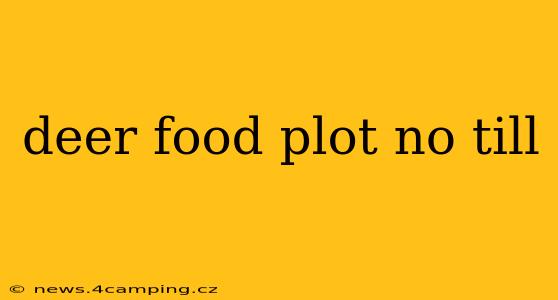Creating a thriving deer food plot doesn't require backbreaking tillage. No-till methods offer significant advantages, from saving time and effort to improving soil health and ultimately boosting your deer hunting success. This guide explores the essentials of establishing and maintaining a successful no-till deer food plot, addressing common questions and concerns.
What are the benefits of no-till deer food plots?
No-till food plots offer numerous benefits over traditional plowed plots. These include:
- Reduced Soil Erosion: Eliminating plowing dramatically reduces soil erosion, especially on slopes, preserving valuable topsoil and nutrients.
- Improved Soil Health: No-till practices increase soil organic matter, leading to better water retention, increased microbial activity, and improved nutrient cycling. A healthier soil supports healthier plants.
- Time and Cost Savings: No-till significantly reduces the time and expense associated with plowing, disking, and harrowing.
- Less Weed Pressure (Potentially): While not guaranteed, no-till can sometimes reduce weed pressure, as fewer weed seeds are brought to the surface during cultivation.
- Better Water Infiltration: Intact soil structure allows for better water infiltration, reducing runoff and improving drought tolerance for your food plot plants.
What are the best seeds for a no-till deer food plot?
Choosing the right seeds is crucial for a successful no-till food plot. Forage species known for their tolerance to less-than-ideal soil conditions and ease of establishment without tillage are ideal. These include:
- Winter Wheat: A reliable cool-season option providing excellent fall and winter forage.
- Oats: A fast-growing option, ideal for quick establishment and early-season grazing.
- Brassicas (Turnips, Rape, Radishes): Provide high-energy forage in the fall and winter, attracting deer with their pungent aroma.
- Clover (White, Red, Alsike): Excellent legumes that improve soil health and provide long-term forage. They are often used in mixes.
- Chicory: A perennial option providing long-lasting forage.
How do I plant a no-till deer food plot?
Establishing a no-till food plot involves several key steps:
- Site Selection: Choose a sunny location with well-drained soil.
- Weed Control: Control existing weeds using herbicides, carefully following label instructions and choosing a product appropriate for your target weeds and desired planting time. Glyphosate (Roundup) is commonly used, but always check state regulations and herbicide labels. Careful timing is crucial to avoid harming your chosen seeds.
- Soil Testing: While not strictly necessary, a soil test can inform you about nutrient deficiencies, allowing you to amend the soil accordingly before planting.
- Seedbed Preparation: While you won't be plowing, a light harrowing or use of a cultipacker can be beneficial to create a slightly disturbed surface for improved seed-to-soil contact. This step can be skipped in some situations.
- Seeding: Use a no-till drill or broadcast seeder for optimal results. Follow seed spacing and depth recommendations on the seed packet.
- Fertilization: Apply fertilizer according to soil test results or general recommendations for your chosen species.
Can I plant a no-till food plot in the fall?
Yes, fall planting is a viable option for many cool-season species like winter wheat, oats, and brassicas. Fall planting allows the plants to establish a root system before winter, resulting in vigorous growth in the spring.
What are the challenges of no-till deer food plots?
While no-till offers many advantages, potential challenges include:
- Weed Competition: Existing weeds can compete with your food plot plants for resources, especially in the early stages of growth. Thorough weed control is critical.
- Pest and Disease Issues: No-till can sometimes increase the risk of certain pest and disease problems. Crop rotation and proper plant selection can help mitigate these risks.
- Nutrient Management: While no-till improves soil health, effective nutrient management is still essential to maximize yield. Soil testing and targeted fertilization are recommended.
How do I maintain a no-till deer food plot?
Maintaining a no-till deer food plot involves minimizing soil disturbance. This includes avoiding tillage and managing weeds through targeted herbicide application or hand weeding. Regular fertilization, according to soil test results, is vital to maintain plant vigor and productivity. Consider incorporating cover crops between food plot plantings to further improve soil health and reduce weed pressure.
By following these guidelines and adapting your approach to your specific conditions, you can create a thriving no-till deer food plot that enhances your hunting property and provides abundant forage for your local deer population. Remember always to consult local regulations regarding herbicide use and hunting practices.
